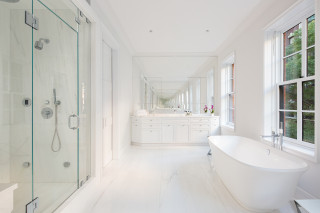Posted by Leonard Steinberg on April 1st, 2012
In the past 10 years we have seen a radical acceleration of evolution in the way we live as human beings: politicians (as always) keep trying to fight this fact, but we can physically witness evolution in our daily lives. Here are some items that I have identified in our homes that should/could be clear enough evidence for all.
Skinny, wall hung Plasma and LCD televisions have replaced most of the old traditional boxy TV’s we all used to have, freeing up to 8 square feet of living space in many instances where those hideous monster big screen TV’s used to take up half of the living room of the Wall Street bachelor pad. In Manhattan, those square feet saved are worth at least $ 5,000……$ 25,000+ in some buildings….PER TELEVISION.
I-pad’s and laptop computers havd removed the bulk of the need for a ‘work desk’…..and the work desk can certainly be much smaller now. Thats a lot of square footage too!
Remember those huge filing cabinets for all the paperwork we used to file away? Well, certain papers are still essential, yet most can be stored in a computer or scanned. More square footage saved.
In recent years, super-high-end apartments would boast about ‘the rack’, a stack of equipment that controlled all the tech throughout the apartment. While these racks are still necessary for many home automation systems, they are getting smaller. And SONOS system eliminates the need for these racks if a more basic system is desired.
We have more wall and counter space where landline telephones used to be placed. We have more ceiling height now that recessed can lights use much smaller LED lamps. Speakers are housed in walls and ceilings. All of a sudden a 6 burner Miele cooktop with 2 seperate ovens is more in Vogue than a massive Viking range.
Last week the New York Times discussed how furniture designers are re-thinking furniture usage in a high tech world: desk lamps with built in chargers or power sources for a laptop? Mirrors that house TV’s (they exist widely already, although they are not 100% effective yet)? Walls that double as storage? Dual functionality equals space and efficiency savings. What about wall thick (approx 8″) tech mechanicals to be able to embed them in the walls for surround sound systems so they aren’t always the hideous visuals below a TV?
We are seeing beds housed in ceilings that drop when needed (an alternative to the space-saving Murphy bed). Stairways that are storage rooms. Artwork that can change and ‘shuffle’…..a la Bill Gates’ house. Windows that wash themselves (they exist!). Window shading built into the glass electronically eliminating the need for shade pockets. Windows that produce energy. A newspaper rack is no longer necessary when we read ‘newspapers’ on line.
We also will witness evolution backlash: those white Apple earphones that were all the rage a few years ago, have been replaced by much larger BEATS headphones with a decidedly retro-cool vibe. Retro will always slow evolution for a while.
As the world population grows, and the need for energy and resource conservation grows, so too will the need for efficiencies of humans grow. The marriage of technology and design is rather new, but the increasing esthetic awareness is huge. Apple probably takes credit for most of this phenomenon.
Designers and their tech counterparts will be challenged to design that which is both functional and desirable. Design that makes out lives easier will win. Yes, efficient spaces are inevitable. But claustrophobic, unattractive design will not survive. Super-luxe tech will provide huge opportunities too. Soon we will probably have all our tech implanted into our bodies…..a scary thought. Then again, whoever thought 10 years ago that we would be watching movies in the palm of our hands on a phone?
We are witnessing what Phillipe Starck terms the DEMATERIALIZATION of society, where less ‘things’ are needed to function. Now tell that to the Kardashians!
